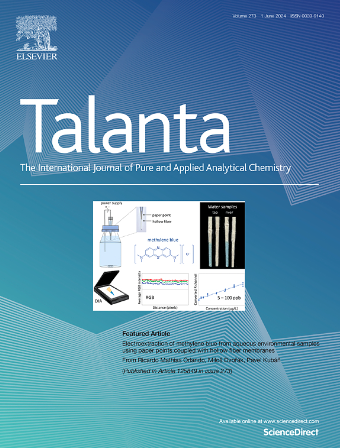同时检测玉米赤霉烯酮和赭曲霉毒素a的CRISPR/ cas12a辅助荧光适配体传感器的建立
IF 6.1
1区 化学
Q1 CHEMISTRY, ANALYTICAL
引用次数: 0
摘要
玉米赤霉烯酮(ZEN)和赭曲霉毒素A (OTA)等真菌毒素对人类和动物健康都有重大危害,需要对食品、饲料和环境中的真菌毒素水平进行严格监测和监管。本研究提出了一种简单高效的CRISPR/ cas12a辅助荧光适配体传感器,用于同时检测ZEN和OTA。利用双功能适体(B-APT),该生物传感器实现对两个靶标的双重识别,随后通过Cas12a/crRNA顺式切割活性将其浓度转化为可观察的荧光信号。对两个靶标的互补链进行合理修饰,可以在相同的激发光下实现不同的发射波长,从而促进ZEN和OTA的同时独立定量测定。在优化条件下,CRISPR/ cas12a - aptassensor对单个ZEN和OTA靶标及其混合物表现出强大的检测能力,并产生一致的标准曲线。该方法对ZEN和OTA浓度范围为0.25 ~ 256 nM和1 ~ 1024 nM的检测结果可靠,检出限分别为190 pM和931 pM。此外,该方法在玉米油样品中显示出卓越的选择性和可观的回收率(ZEN为89.17% - 109.88%,OTA为101.19% - 106.51%),强调了其作为ZEN和OTA检测的先进工具的有效性,并为同时检测多种目标提供了有价值的见解。本文章由计算机程序翻译,如有差异,请以英文原文为准。

Development of a CRISPR/Cas12a-assisted fluorescent aptasensor for simultaneous detection of zearalenone and ochratoxin A
Mycotoxins, such as zearalenone (ZEN) and ochratoxin A (OTA), represent significant hazards to both human and animal health, necessitating strict monitoring and regulation of mycotoxin levels in food, feed, and environment. In this study, a simple and efficient CRISPR/Cas12a-assisted fluorescent aptasensor is presented for the simultaneous detection of ZEN and OTA. Utilizing a Bifunctional aptamer (B-APT), this biosensor achieves dual recognition of the both targets, subsequently converting their concentrations into observable fluorescent signals through the Cas12a/crRNA cis-cleavage activity. Rational modifications of the complementary strands specific to the two targets enable distinct emission wavelengths under the same excitation light, facilitating simultaneous and independent quantitative determination of ZEN and OTA. Under optimized conditions, the CRISPR/Cas12a-aptasensor demonstrates robust detection capabilities for individual ZEN and OTA targets, as well as their mixture, yielding consistent standard curves. This methodology exhibits reliable detection of ZEN and OTA concentrations spanning from 0.25 nM to 256 nM and 1 nM to 1024 nM, with respective limit of detection (LOD) values of 190 pM and 931 pM. Furthermore, this method showcases exceptional selectivity and considerable recovery rates (89.17 %–109.88 % for ZEN and 101.19 %–106.51 % for OTA) in corn oil samples, underscoring its efficacy as an advanced tool for ZEN and OTA detection and offering valuable insights into the simultaneous detection of diverse targets.
求助全文
通过发布文献求助,成功后即可免费获取论文全文。
去求助
来源期刊

Talanta
化学-分析化学
CiteScore
12.30
自引率
4.90%
发文量
861
审稿时长
29 days
期刊介绍:
Talanta provides a forum for the publication of original research papers, short communications, and critical reviews in all branches of pure and applied analytical chemistry. Papers are evaluated based on established guidelines, including the fundamental nature of the study, scientific novelty, substantial improvement or advantage over existing technology or methods, and demonstrated analytical applicability. Original research papers on fundamental studies, and on novel sensor and instrumentation developments, are encouraged. Novel or improved applications in areas such as clinical and biological chemistry, environmental analysis, geochemistry, materials science and engineering, and analytical platforms for omics development are welcome.
Analytical performance of methods should be determined, including interference and matrix effects, and methods should be validated by comparison with a standard method, or analysis of a certified reference material. Simple spiking recoveries may not be sufficient. The developed method should especially comprise information on selectivity, sensitivity, detection limits, accuracy, and reliability. However, applying official validation or robustness studies to a routine method or technique does not necessarily constitute novelty. Proper statistical treatment of the data should be provided. Relevant literature should be cited, including related publications by the authors, and authors should discuss how their proposed methodology compares with previously reported methods.
 求助内容:
求助内容: 应助结果提醒方式:
应助结果提醒方式:


